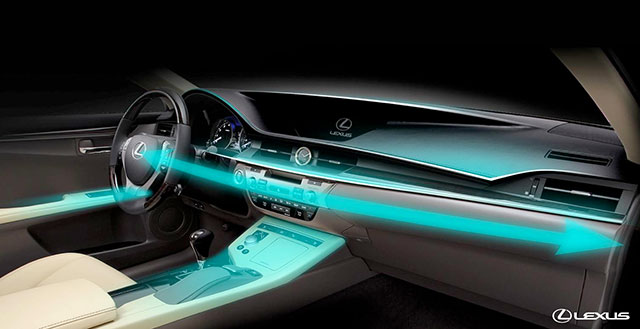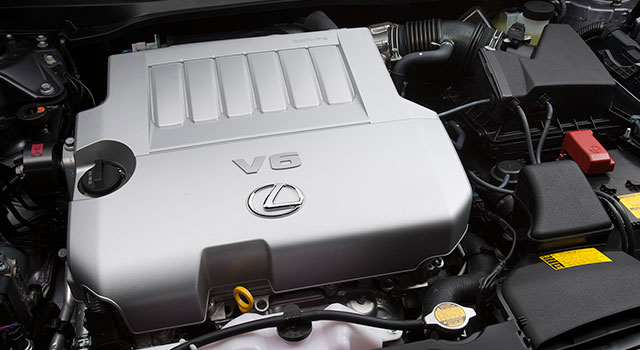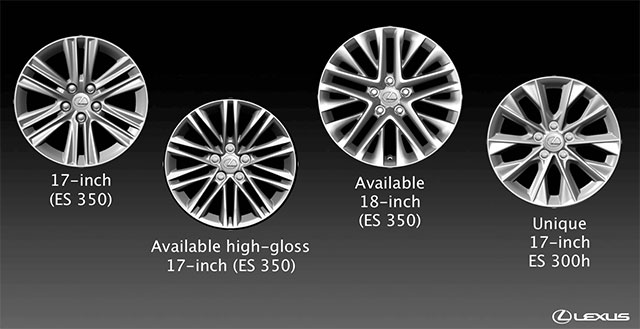Earlier this month, Lexus invited me to Newberg, Oregon, where I had the chance to try out the all-new sixth generation Lexus ES. The following is an overview of the new model — my personal impressions on the ES 350 & ES 300h will follow this weekend.
The ES sedan has been a staple of the Lexus brand since the very beginning, when the first-generation ES 250 was introduced alongside the flagship LS sedan at the 1989 Detroit Auto Show.
Over the last twenty-three years and five model generations, the ES has stayed its course as a full-size luxury sedan at an entry-level luxury price, making it a unique vehicle that competitors have yet to find an answer for. This latest edition, introduced at the New York Auto Show in April, takes the ES formula and refactors it, with an increase in overall size, a fresh and unexpected level of performance, and a significant upgrade to both the exterior and interior.
Please note that clicking on any image in this overview will display a larger version.
Exterior Design
In setting out to design the new ES, Lexus engineers had some very clear objectives:
- Increase the appeal of the model to younger buyers, and
- Incorporate the new L-Finesse design cues.
The first point is entirely subjective and up for discussion, but the L-Finesse update introduced with the fourth-generation GS is reflected throughout the exterior, starting with the spindle grille:

The ES now has a lower profile with an emphasis on aerodynamics, best illustrated with this graphic:
Here we can see the pronounced wheel flares and the straight-line airflow, which Lexus defines as a “flowing silhouette with pulled-in corners”.
The other functional design elements that help to direct air around the ES are fins built into the side mirror, the taillights and the panels underneath the vehicle:
Here are the ES aerodynamics in action:
But perhaps the most noticeable difference from the previous generation ES is the larger size:

Compared to the previous generation, the overall size has increased by 1.0 inch (25.4mm) and the wheelbase has jumped 1.8 inches (45.7mm) — this additional space has been used to boost the rear seat room.
Interior
The ES interior has been designed to use the two-zone template first seen in the third generation RX, with a clear break between the operation zone (highlighted in blue) and the display zone, which takes up the upper portion of the dash:
The front seats have been redesigned and are more driver-focused, with an adjusted steering wheel position and greater height flexibility:
The ES now features the same steering wheel as the GS, a very noticeable upgrade over the current generation:
Of course, the biggest change by far is in the rear seats, where every dimension has been increased:
Lastly, here’s a photo of the night ambient lighting :
(Also available in the Ultra Luxury package is a panoramic glass roof.)
Audio & Navigation
The ES is offered with three different audio controllers:
- The base system has hardware audio controls and a LCD display built into the head unit.
- The ES is also offered with the Display Audio controller, which uses a dial to control the audio and climate controls via a 7-inch dash display.
- Finally, there is the second-generation Remote Touch controller, which uses a 8-inch display for audio control, climate control, and navigation. This option also includes Enform with built-in Internet app functionality.
There are also two audio system levels:
- The base system features eight speakers, Bluetooth audio, USB functionality and HD radio.
- The upgraded Mark Levinson audio system has fifteen speakers kicking out 835 watts.
ES 350 Technical Details
The ES 350 continues to be powered by the 2GR-FE 3.5L V6 engine from the previous generation, which pushes out 268 hp and 248 lb.ft of torque and delivers 21 city/31 highway/24 combined mpg. Also carried over is the six-speed transmission.
However, one major improvement is the addition of the Lexus Drive Mode Select, which comes standard in every new ES. Three modes are available:
- Normal: The baseline between performance and fuel efficiency.
- ECO: Maximizes fuel savings by smoothing out throttle application and moderating the air conditioning
- Power: Full throttle control along with adjustments to the steering feel
ES 300h Technical Details
The ES 300h is powered by a 2AR-FXE 2.5L 4-cylinder Atkinson Cycle hybrid engine, mated with a E-CVT transaxle that uses two electric motors — one to generate electricity, the other to use electricity. As a result, the ES 300h has a combined 200 hp and 156 lb.ft of torque, and delivers an estimated 40 city/39 highway/39 combined mpg.
The ES 300h is also equipped with the same Drive Mode Select as the standard gas ES 350, but picks up an EV mode option that allows the vehicle to the vehicle go approximately 25 mph for up to a half mile purely on electric power.
One impressive aspect of the ES 300h is the compact design of the battery pack, which sits directly behind the rear seats:
Suspension & Chassis
Using similar techniques seen with the fourth generation GS, the new ES has moved to a more balanced suspension — there is still an emphasis on ride comfort, but handling has been much improved.
One focus was on body rigidity, with high-tensile-strength sheet steel used throughout the body (reducing weight by almost 90 pounds) and a number of braces added to the rear subframe:
Additionally, the ES now has opposite-wound front coil springs, a revised rear suspension, and adjusted shock absorbers — all meant to improve ride comfort and overall stability. The Electric Power Steering (EPS) has also been reconfigured with a quicker ratio to improve responsiveness.
Safety Features
Beyond the ten airbags installed in the ES, there are a number of active safety features available, starting with the Blind Spot Monitor with Rear Cross Traffic Alert — two features best demonstrated by video:
Also added to the ES was Lane-Departure Alert:
Two other notable safety features: Intuitive Park Assist, which helps guide the driver into a parking spot using sonar, and automatic high beams.
Color & Wheel Options
The ES will debut the Silver Lining exterior color — the remainder are all existing Lexus colors:
The ES will be available in three interior colors — Black, Light Gray & Parchment:
The ES 350 and ES 300h will both get an exclusive wood trim option, with Birdseye Maple for the ES 350 and Bamboo for the ES hybrid:
The bamboo in the ES 300h is a much darker color than the wood previously seen in the GS hybrid — this is to prevent windshield glare.
The ES will be available with four different wheel designs:
Standard Equipment
For the ES 350, standard equipment will include Drive Mode Select, LED daytime running lights, a power moonroof, 17-in. alloy wheels, smart key, automatic temperature control, 10-way power driver and passenger front seats, a NuLuxe interior, Bluetooth, and a tire pressure monitoring system.
For the ES 300h, standard equipment is the same as with the ES 350, but also includes EV Mode, unique 17-inch alloy wheels, a rear spoiler, hidden exhaust, and Bamboo interior trim.
Packages
In the USA, the ES will be offered with three packages, all of which will require either the optional Display Audio or Navigation system:
- Premium Package (ES350/ES300h): Genuine wood trim, wood-trimmed and leather-wrapped steering wheel and shift knob, NuLuxe seat trim, driver seat memory, and the power tilt/telescopic steering wheel.
- Luxury Package (ES 350/ES 300h): Premium Package plus HID headlamps, leather-trimmed interior, climate controlled seats (heated and ventilated), power rear sunshade, and Intuitive Park Assist.
- Ultra Luxury Package (ES350/ES300h): Luxury Package plus the panoramic glass roof (ES 350 only), rain-sensing wipers with de-icer, heated wood steering wheel, passenger seat memory, driver’s seat cushion extender, ambient lighting, manual rear door shades, and one-touch power trunk.
There are also a number of separate factory options available, including Lexus Display Audio, the navigation package, navigation with Mark Levinson audio, Lexus Pre-Collision System (PCS) with dynamic radar cruise control, blind spot monitor with rear cross-traffic alert, and lane departure assist with auto high-beams.
This ends my technical overview of the 2013 ES — check back on the weekend for my personal impressions of both the ES 350 & ES 300h as I take to the roads of Newberg, Oregon. Special thanks to Lexus for inviting me to this event.






















Comments